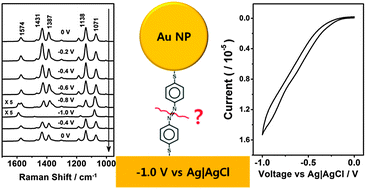Surface-enhanced Raman scattering of 4,4′-dimercaptoazobenzene trapped in Au nanogaps†
Abstract
The surface-enhanced Raman scattering (

* Corresponding authors
a
Department of Chemistry, Seoul National University, Seoul 151-742, Korea
E-mail:
kwankim@snu.ac.kr
Fax: +82-2-8891568
Tel: +82-2-8806651
b
Department of Chemistry, Soongsil University, Seoul 156-743, Korea
E-mail:
kshin@ssu.ac.kr
Fax: +82-2-8144076
Tel: +82-2-8200436
The surface-enhanced Raman scattering (

 Please wait while we load your content...
Something went wrong. Try again?
Please wait while we load your content...
Something went wrong. Try again?
K. Kim, D. Shin, K. L. Kim and K. S. Shin, Phys. Chem. Chem. Phys., 2012, 14, 4095 DOI: 10.1039/C2CP24135H
To request permission to reproduce material from this article, please go to the Copyright Clearance Center request page.
If you are an author contributing to an RSC publication, you do not need to request permission provided correct acknowledgement is given.
If you are the author of this article, you do not need to request permission to reproduce figures and diagrams provided correct acknowledgement is given. If you want to reproduce the whole article in a third-party publication (excluding your thesis/dissertation for which permission is not required) please go to the Copyright Clearance Center request page.
Read more about how to correctly acknowledge RSC content.
 Fetching data from CrossRef.
Fetching data from CrossRef.
This may take some time to load.
Loading related content
